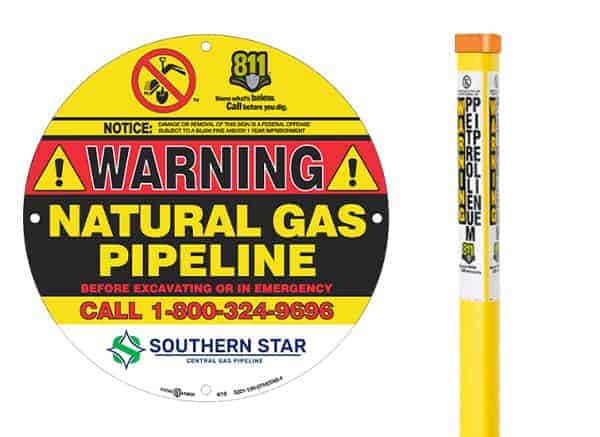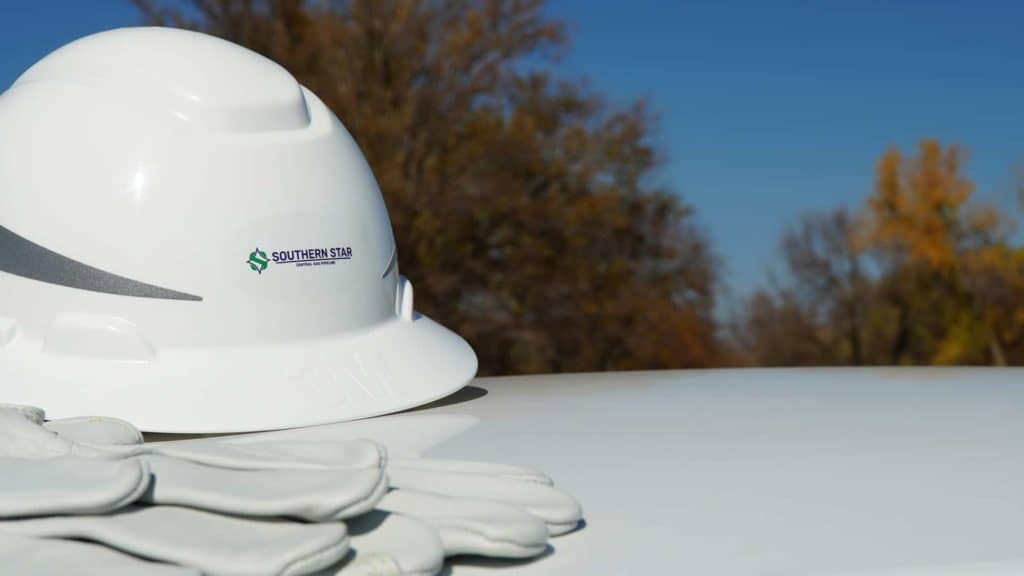Pipeline Safety
Our Commitment
Southern Star monitors our pipeline 24 hours a day, seven days a week. We ensure the safe and reliable operation of our pipeline through routine inspections, computer monitoring systems, corrosion protection, maintenance, regular employee training and more.
If you have any questions, you can call Southern Star's Public Awareness Team at 1-888-885-6008 or e-mail us at PublicAwareness@SouthernStar.com.
Our pipeline is designed, tested, installed, operated and maintained in accordance with all applicable federal and state requirements including the statutes governing the operations of natural gas companies and all rules and regulations adopted by the Federal Energy Regulatory Commission (FERC), as well as our FERC approved tariff.
If you have any ethical questions or concerns about Southern Star, please call 1-800-662-3870.
Call Before You Dig!
Most pipeline accidents occur when individuals are not aware of a pipeline's location before they begin their work. The best way to solve this issue is to remember to call before you dig! Whether you are a homeowner or a professional excavator, one phone call to 811 starts the process to get underground pipelines and utility lines marked for FREE. Call 811 if you are planning any digging project, whether you're planting shrubs in your yard or beginning work near a major gas pipeline right-of-way. When you call 811 from anywhere in the country, your call will be routed to your state's One-Call Center. Within two business days, the underground pipelines and utility lines around your home, business or property will be marked and you will be able to dig safely. If you prefer to go online to report your digging plan, visit call811.com.
Most pipelines are buried underground to protect them from the elements and minimize interference with surface uses. Pipeline rights-of-way are clearly identified by pipeline markers that identify the approximate - NOT EXACT - location of the pipeline. Every pipeline marker contains information identifying the company that operates the pipeline, the product transported, and a phone number that should be called in the event of an emergency.
Markers do not indicate pipeline burial depth, which will vary. Markers are typically seen where a pipeline intersects a street, highway or railway. You will also find them at water crossings, fence lines and property boundaries. It is a federal crime for any person to willfully deface, damage, remove, or destroy any pipeline marker.
The National Pipeline Mapping System (NPMS) can be a great resource for tasks such as emergency response and smart growth planning, but it does not take the place of calling 811 before any excavation. Click here visit NPMS.

Pipeline Marker
This marker is the most common. It contains operator information, type of product and an emergency contact number. Size, shape and color may vary.

Aerial Marker
These skyward facing markers are used by patrol planes that monitor pipeline routes.

Casing Vent Marker
This marker indicates that a pipeline (protected by a steel outer casing) passes beneath a nearby roadway, rail line or other crossing.

Sight
Natural gas is colorless, but vapor and "ground frosting" may be visible at high pressures. A natural gas leak may also be indicated by bubbles in wet or flooded areas, distinct patches of dead vegetation, dust blowing from a hole in the ground or flames if the leak is ignited.

Sound
Volume can range from a quiet hissing to a loud roar depending on the size of the leak and pipeline system.

Smell
An unusual smell or gaseous odor will sometimes accompany pipeline leaks. Natural Gas is colorless, tasteless and odorless unless commercial odorants or Mercaptan are added. Gas transmission/gas gathering pipelines are odorless, but may contain a hydrocarbon smell.

Dos
Turn off any equipment and eliminate any ignition sources without risking injury.
Leave the area by foot immediately. Try to direct any other bystanders to leave the area. Attempt to stay upwind.
From a safe location, notify the pipeline operator immediately and call 911 or your local emergency response number. The operator will need your name, your phone number, a brief description of the incident, and the location so they can initiate the proper response.

Don'ts
DO NOT cause any open flame or other potential source of ignition such as an electrical switch, vehicle ignition, burning match, etc. Do not start motor vehicles or electrical equipment. Do not ring doorbells to notify others of the leak. Knock with your hand to avoid potential sparks from knockers.
DO NOT come into direct contact with any escaping liquids or gas.
DO NOT drive into a leak or vapor cloud while leaving the area.
DO NOT attempt to operate any pipeline valves yourself. You may inadvertently route more product to the leak or cause a secondary incident.
DO NOT attempt to extinguish a petroleum product or natural gas fire. Wait for local firemen and other professionals trained to deal with such emergencies.
If you cause or witness even minor damage to a pipeline or its protective coating, please immediately notify the pipeline company. Even a small disturbance to a pipeline may cause a future leak. A gouge, scrape, dent or crease is cause enough for the company to inspect the damage and make repairs.
All damages to underground gas or hazardous liquid pipeline facilities in the State of Texas are required by law to be reported to the Railroad Commission of Texas online at www.rrc.state.tx.us. Excavators must notify the pipeline company through the One-Call Center immediately and no later than two hours following the damage incident.
With the passage of the Pipeline Safety Improvement Act of 2002 (PSIA), the United States Congress mandated that specific requirements be implemented for ensuring the integrity of liquid and natural gas pipeline systems throughout the United States. This legislation, and subsequent regulations codified by the U.S. Department of Transportation (DOT), require pipeline operators to develop programs to improve how they manage the integrity of their pipeline systems.
Southern Star has developed its Integrity Management Program (IMP) to more effectively perform safety-related activities such as testing and inspections, repairs, and maintenance of the pipeline system. Furthermore, our program is critical in determining the prioritization and timeline of pipeline integrity work while also standardizing the manner in which Southern Star continually monitors and documents the work associated with the integrity of the pipeline, specifically within High Consequence Areas (HCAs).
An HCA is a location that is defined by pipeline safety regulations as an area where pipeline releases could have greater consequences to health and safety or the environment. HCAs are generated when the Potential Impact Circle (PIC) of the pipeline encompasses 20 or more buildings intended for human occupancy or an identified site.
The PIC is the circle within which the potential failure of a pipeline could have significant impact on people or property.
An identified site is one of the following:
- An outside area or open structure that is occupied by 20 or more persons on at least 50 days in any 12-month period. The days need not be consecutive. Examples include but are not limited to, beaches, playgrounds, recreational facilities, camping grounds, outdoor theaters, stadiums, recreational areas near bodies of water
- Religious facilities, office buildings, community centers, general stores, or other buildings of this nature, that are occupied by 20 or more people on at least five (5) days a week for 10 weeks in a 12-month period (the days and weeks need not be consecutive)
- Schools, day-care facilities, retirement facilities, prisons, assisted-living facilities, hospitals, or other facilities occupied by persons who are confined, are of impaired mobility, or who would be difficult to evacuate.
Southern Star's IMP (Integrity Management Program) includes the following elements:
- Identification of High Consequence Areas
- Baseline Assessment Plan & Performing Integrity Assessment
- Remediating Conditions
- Continual Evaluation and Assessment
- Preventive & Mitigative Measures
- Performance Plan
- Management of Change
- Quality Assurance
- Internal & External Communications
Southern Star is committed to continuing to operate safe and reliable pipelines. Senior Management fully supports the processes and procedures contained in our IMP and has directed employees to meet the goals and objectives of the program.

Emergency Response
Southern Star has an established emergency response plan in the rare case that a pipeline failure should occur. Potential hazards that may be associated with pipeline failure include line rupture, release of natural gas, fire, and explosion.
Our operations personnel are well-prepared to respond appropriately and manage an emergency. We work closely and cooperate with local emergency responders to provide education about our pipeline operations and how to respond in the unlikely event of an emergency.
In case of a pipeline emergency, Southern Star personnel will respond immediately with the following actions:

Activate our response plan

Ensure the safety of the public, our customers, and our team

Support first responders and the appropriate public officials and provide appropriate resources

Provide information regarding the status of the event
Land Use Development
Southern Star easements are generally 66 feet wide, unless specifically noted otherwise in the applicable easements. As such, the standard encroachment drawings provided on this site assume a 66-foot total right-of-way width, or 33-feet on each side of the pipeline and are provided only as a guide to assist in planning your project. To verify the right of way width in the area of your project, please contact the land representative nearest you.
Please be aware that Southern Star's engineering department must review and approve plans for any work within our rights-of-way at least 60 days before the beginning of actual work on the project. A specific encroachment agreement may be required prior to you beginning to work within Southern Star's right of way. Your land representative will be glad to visit with you regarding that agreement.
Provided below is a toolkit outlining the standards and procedures to be followed when planning land use development on or near Southern Star Central Gas Pipeline rights-of-way.
The handbook is intended for use by city and county planners, engineers, developers, land surveyors and anyone involved in the initial stages of land development. If Southern Star is included in the initial planning stages, project delays can be avoided and safe development practices in the vicinity of pipelines can be attained.
The toolkit is designed to make you aware of the most common standards and procedures Southern Star typically requires to protect its facilities in areas of changing land use. However, each proposed development or activity requires a case-specific evaluation by a qualified Southern Star representative. Again, the sooner you involve Southern Star in your project, the better.
Land Development Toolkit
- Land Use Development and Right of Way Handbook
- Right of Way Clearing & Vegetation Management
- Standard Width of Right-Of-Way
- Timber Bridge Pg. 1
- Timber Bridge Pg. 2
- Overhead Power Lines
- Underground Power & Fiber Optic
- Foreign Pipeline Crossing
- Underground Phone and Cable
- Standard Road Crossing
- Special Road Crossing
- Bored Utility Crossing
- Underground Electric & Fiber Optic Crossings
Land Department
FERC Citizen Guides
From the Federal Energy Regulatory Commission:
Safety Brochures
If you are a member of one of the audiences below, please take a minute to review the information in your relevant pipeline safety brochures and High Consequence Areas (HCA) brochures:

High Consequence Areas (HCAs)
